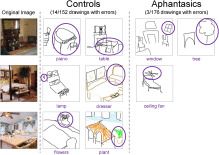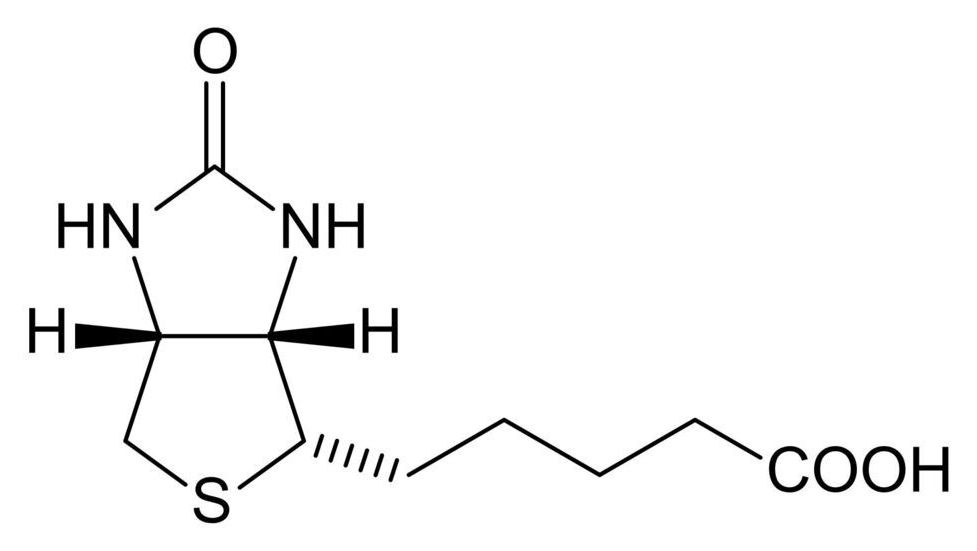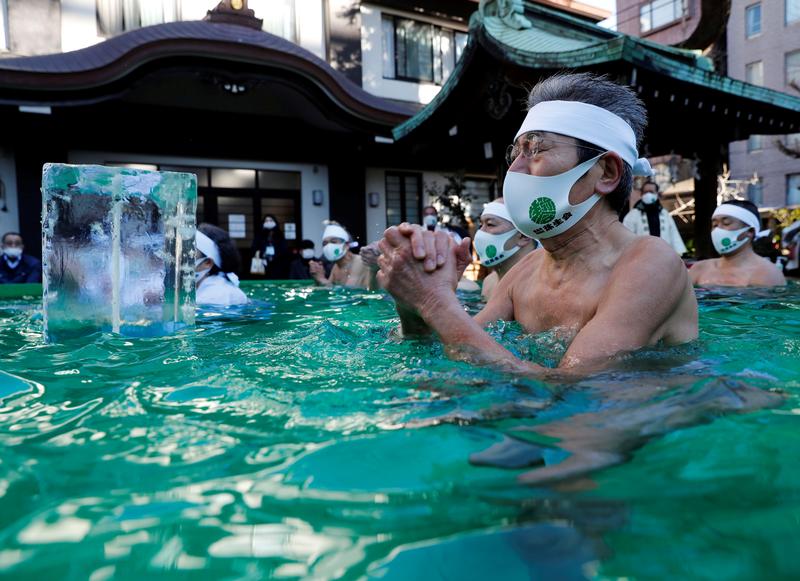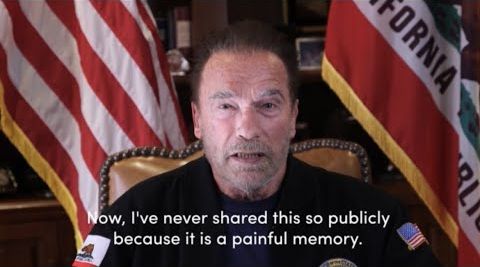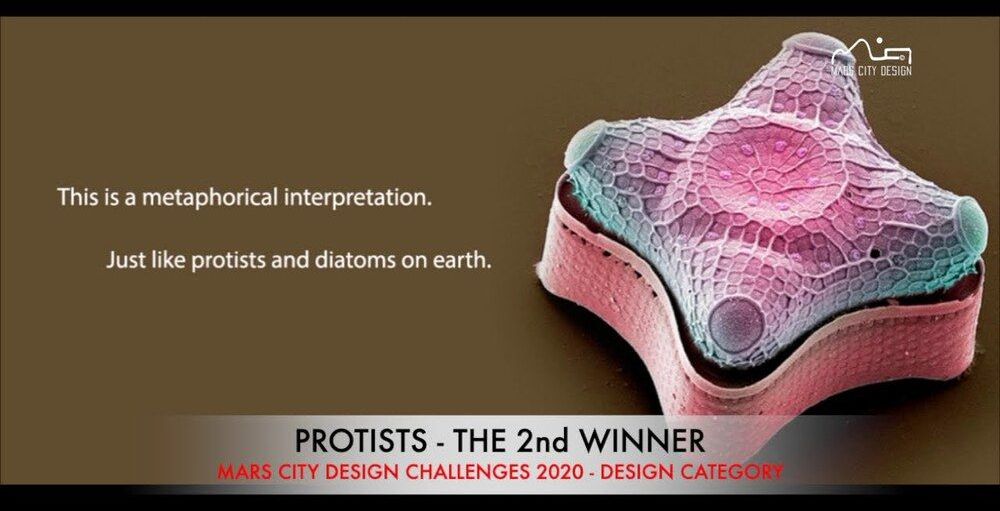Congenital aphantasia is a recently characterized variation of experience defined by the inability to form voluntary visual imagery, in individuals who are otherwise high performing. Because of this specific deficit to visual imagery, individuals with aphantasia serve as an ideal group for probing the nature of representations in visual memory, particularly the interplay of object, spatial, and symbolic information. Here, we conducted a large-scale online study of aphantasia and revealed a dissociation in object and spatial content in their memory representations. Sixty-one individuals with aphantasia and matched controls with typical imagery studied real-world scene images, and were asked to draw them from memory, and then later copy them during a matched perceptual condition. Drawings were objectively quantified by 2795 online scorers for object and spatial details. Aphantasic participants recalled significantly fewer objects than controls, with less color in their drawings, and an increased reliance on verbal scaffolding. However, aphantasic participants showed high spatial accuracy equivalent to controls, and made significantly fewer memory errors. These differences between groups only manifested during recall, with no differences between groups during the matched perceptual condition. This object-specific memory impairment in individuals with aphantasia provides evidence for separate systems in memory that support object versus spatial information. The study also provides an important experimental validation for the existence of aphantasia as a variation in human imagery experience.
Methylation and demethylation of DNA, RNA and proteins has emerged as a major regulatory mechanism. Studying the function of these modifications would benefit from tools for their site‐specific inhibition and timed removal. S ‐Adenosyl‐L‐methionine (AdoMet) analogs in combination with methyltransferases (MTases) have proven useful to map or block and release MTase target sites, however their enzymatic generation has been limited to aliphatic groups at the sulfur atom. We engineered a SAM synthetase from Cryptosporidium hominis (PC‐ChMAT) for efficient generation of AdoMet analogs with photocaging groups that are not accepted by any WT MAT reported to date. The crystal structure of PC‐ChMAT at 1.87 Å revealed how the photocaged AdoMet analog is accommodated and guided engineering of a thermostable MAT from Methanocaldococcus jannaschii. PC‐MATs were compatible with DNA‐ and RNA‐MTases, enabling sequence‐specific modification (“writing”) of plasmid DNA and light‐triggered removal (“erasing”).
The extent to which nonhuman primate vocalizations are amenable to modification through experience is relevant for understanding the substrate from which human speech evolved. We examined the vocal behaviour of Guinea baboons, Papio papio, ranging in the Niokolo Koba National Park in Senegal. Guinea baboons live in a multi-level society, with units nested within parties nested within gangs. We investigated whether the acoustic structure of grunts of 27 male baboons of two gangs varied with party/gang membership and genetic relatedness. Males in this species are philopatric, resulting in increased male relatedness within gangs and parties. Grunts of males that were members of the same social levels were more similar than those of males in different social levels (N = 351 dyads for comparison within and between gangs, and N = 169 dyads within and between parties), but the effect sizes were small. Yet, acoustic similarity did not correlate with genetic relatedness, suggesting that higher amounts of social interactions rather than genetic relatedness promote the observed vocal convergence. We consider this convergence a result of sensory–motor integration and suggest this to be an implicit form of vocal learning shared with humans, in contrast to the goal-directed and intentional explicit form of vocal learning unique to human speech acquisition.
One of the key preconditions for the development of speech is the ability to adjust vocal output in response to auditory input. Humans are exceptionally proficient at vocal learning. Although effortless speech learning is confined to the early years [1], humans still possess the ability to imitate sounds voluntarily and acquire further languages throughout their lives. Numerous comparative studies have aimed at elucidating the evolutionary origins of vocal learning within the primate lineage, to uncover the extent to which nonhuman primates reveal evidence for vocal plasticity, and whether such plasticity may be conceived as a pre-adaptation for the evolution of speech [2, 3].
Despite considerable research effort, it appears that the ability to learn sounds from auditory experience in most nonhuman primate species is limited. Unlike humans or some songbird species, nonhuman primates are not obligatory vocal learners that require species-specific auditory input to develop their normal vocal repertoires [4, 5]. Early attempts to train a young chimpanzee to produce speech sounds yielded disappointing results and prompted most of the ‘ape language’ projects to turn to another modality, using either symbol systems or sign languages [6]. Studies of the neural basis of vocal production in different monkey species found that the animals lack the neural connections necessary for the volitional control over the fine structure of vocalizations, although they exert greater control over the usage of calls (reviewed in [2]).
Futuristic Stair-Climbing Wheelchair
Posted in futurism
A possible wheelchair for the future! 😃
Self-balancing and stair-climbing wheelchair provides more independence.
More info: https://bit.ly/2LigV2x
Biotin is also known as vitamin H, named for the German words “Haar” and “Haut,” which mean hair and skin. This was due to the fact that even slight deficiencies cause hair thinning, skin rash or brittle fingernails. New research, just published in PNAS, now shows that some forms of severe neurodegeneration, like the frontotemporal dementia seen in Alzheimer’s and Parkinson’s, can directly result from lack of sufficient biotin.
The authors discovered this by looking at fruit flies with dementia. Now, before anyone chuckles, fruit flies actually make a nice model of Alzheimer’s or other diseases when they are given the right genes. Human versions of defective MAPT (tau) genes cause these flies to develop tauopathies that resemble those that occur in our own brains. To delve deeper into the neurotoxicity of tau, they looked at over 7000 fly genes in a forward genetic screen before zeroing in on one significantly modified toxicity of the tauR406W mutant. This gene, Btnd, encodes the biotinidase enzyme that extracts biotin from food sources or recycles it from used enzymes.
TOKYO (Reuters) — Men wearing traditional loin clothes and women dressed in white robes clapped and chanted before going into an ice water bath during a Shinto ritual at a Tokyo shrine on Sunday to purify the soul and pray for the end of the COVID-19 pandemic.
Only a dozen people took part in the annual event at Teppou-zu Inari Shrine, scaled down this year due to the health crisis, compared to over a hundred in early 2020. Spectators were not allowed at the event.
After doing warming-up exercises and chanting under a clear sky with outside temperatures at 5.1 degree Celsius (41.18 Fahrenheit), the nine male and three female participants went into a bath filled with cold water and large ice blocks. “I prayed that the coronavirus comes to an end as soon as possible,” said 65-year-old participant Shinji Ooi, who heads the Shrine’s ‘Yayoikai’ parishioner group, after the ritual.
This is my message to my fellow Americans and my friends around the world after January 62021.
The mayor of Paris has said a €250m (£225m) makeover of the Champs-Élysées will go ahead, though the ambitious transformation will not happen before the French capital hosts the 2024 Summer Olympics.
Anne Hidalgo said the planned work, unveiled in 2019 by local community leaders and businesses, would turn the 1.9 km (1.2 mile) stretch of central Paris into “an extraordinary garden”.
The Champs-Élysées committee has been campaigning for a major redesign of the avenue and its surroundings since 2018.
WASHINGTON — The Federal Communications Commission will allow SpaceX to launch 10 Starlink satellites into polar orbit on an upcoming mission, but deferred a decision on a much broader modification of SpaceX’s license.
In an order published Jan. 8, the FCC granted SpaceX permission to launch 10 Starlink satellites into a 560-kilometer orbit with an inclination of 97.6 degrees. Those satellites will launch on a Falcon 9 no earlier than Jan. 14 as part of Transporter-1, a dedicated smallsat rideshare mission.
SpaceX had been lobbying the FCC for weeks for permission to launch Starlink satellites into a polar orbital plane as the FCC considers a modification of the company’s license to lower the orbits of satellites originally authorized for higher altitudes. That included a Nov. 17 request to launch 58 satellites into a single polar orbital plane, citing “an opportunity for a polar launch in December” that it did not identify.
If humans plan to go to live and work beyond Earth someday, they will need technologies that allow for sustainable living in alien environments. This is especially true of Mars, which is extremely cold, dry, and subject to more radiation than we are used to. On top of that, it also takes six to nine months to send spacecraft there, and that’s every two years when Earth and Mars are closest to each other in their orbits.
As such, settling on the Red Planet will require some serious creativity!
This the purpose of Mars City Design (the Mars City®), an innovation and design platform founded by architect and filmmaker Vera Mulyani. Every year since its inception, this organization has hosted the Mars City Design Challenges, where students from around the world come together with industry experts to produce architectural designs for living on Mars (what Mulyani calls “Marchitecture”).
